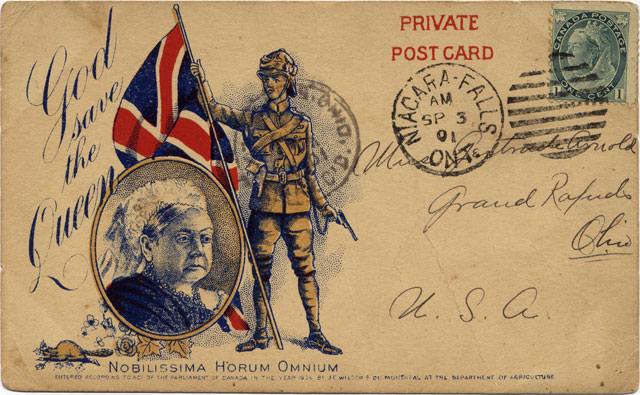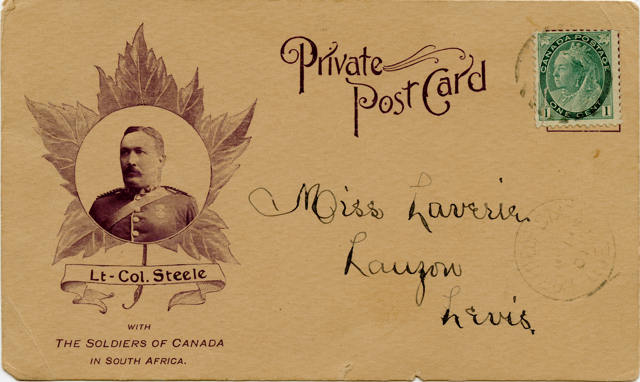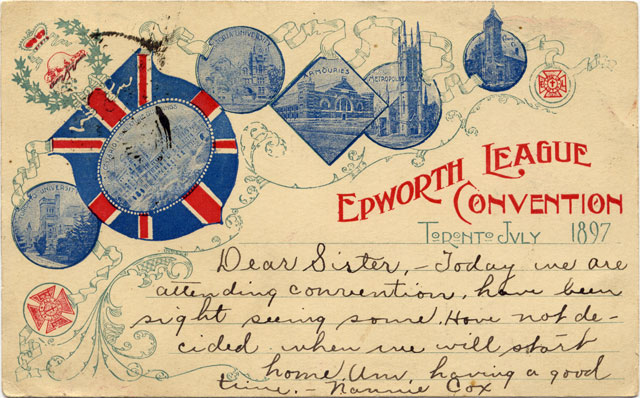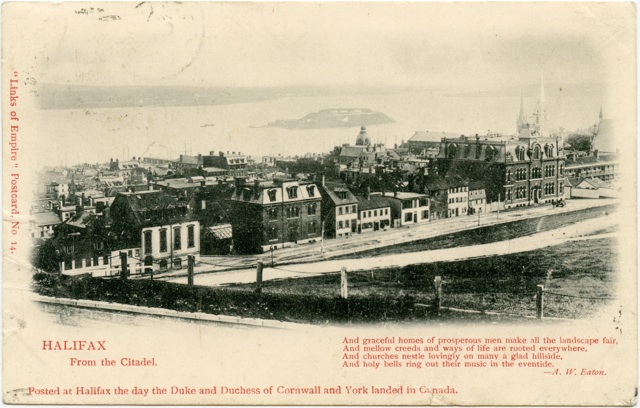If you click on the image above, you will be taken to a page featuring the set of the cards in this series.
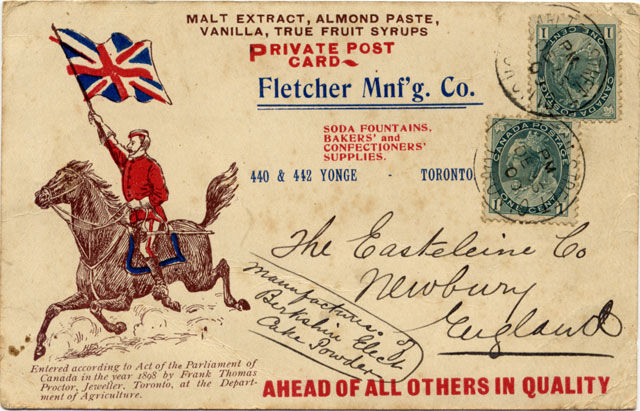
Fletcher Mnf’g. Co,
Soda Fountains, Bakers’ and Confectioners’ Supplies
440 & 442 Yonge Toronto
Private Post-Card
Malt Extract, Almond Paste, Vanilla, True Fruit Syrups
This card is postmarked Dec 25, 1900 with Carleton Street Toronto postmark on a pair of 1¢ QV Numeral stamps sent to The Eastlaine Co., Newbury, England.
In Kenneth Rowe’s 1981 publication The Postal History of the Canadian Contingents, Anglo-Boer War, 1899–1902, published by The Vincent G. Greene Philatelic Research Foundation, he notes this design, shown as Figure 48, was “a typical example of a commercial patriotic design of the period”.
Below, the reverse of the card, showing business use by Fletcher Mnf’g. Co.
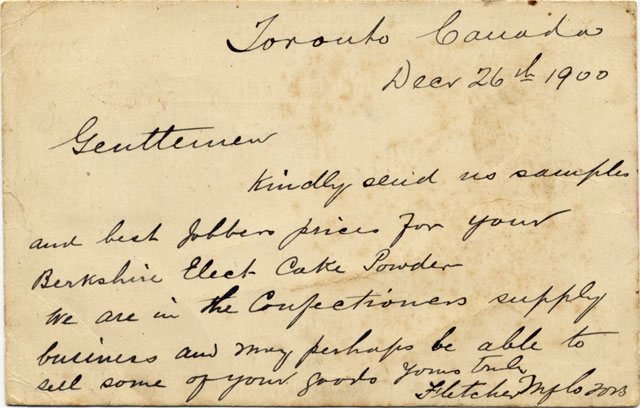
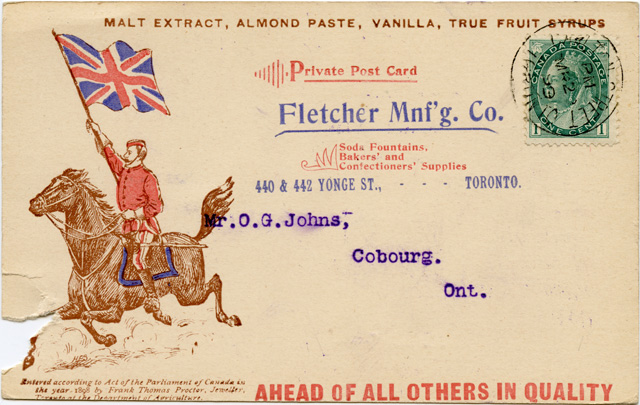
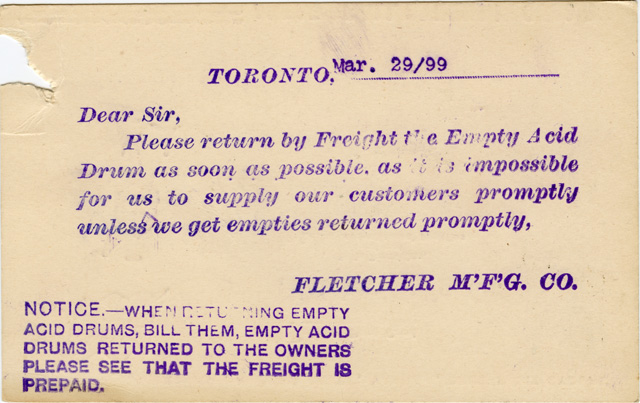
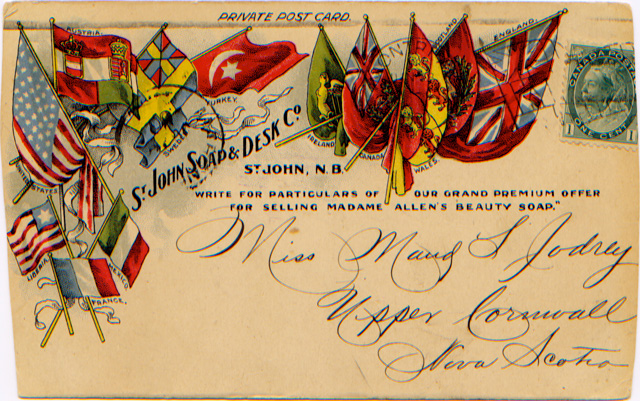
St. John Soap & Desk Co,
St. John, N.B.
“Write for particulars of our grand premium offer
for selling Madame Allen’s beauty soap”
Private Post Card
France, Mexico, Liberia, United States, Sweden, Turkey, Ireland, Canada, Wales, Scotland, England
This patriotic was postmarked June 18, 1900 with a Montreal flag cancellation on 1¢ QV Numeral stamp sent to Miss Maud S. Jodrey, Upper Cornwall, Nova Scotia. Maud Jodrey was born January 27, 1885, daughter of William & Gasanda Jodrey. While the card has been trimmed, the beautiful & colourful design is still evident.
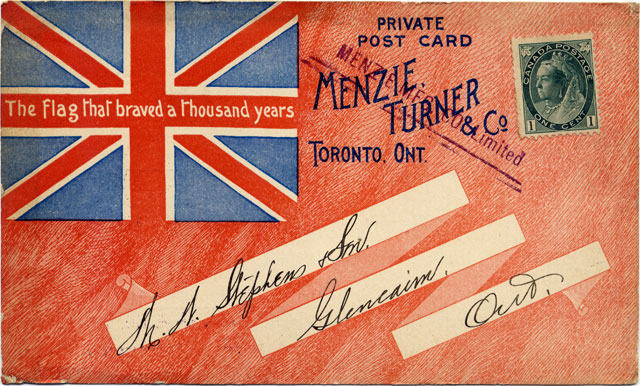
Menzie, Turner & Co,
Toronto, Ontario
Private Post Card
The Flag that braved a thousand years
This patriotic postcard, which plays on an earlier postcard design by J.C. Wilson & Co., was postally used from Toronto on Dec 26, 1901 with a 1¢ QV Numeral stamp, uncancelled to H.W. Stephens & Son, Glencairn, Ontario. The card has been overprinted by a hand stamp noting Menzie Mfg Co. Limited, on front & back, as the new company used up old postcard stock.
Below, the reverse of the card showing a Glencairn split ring cancellation dated December 27, 1901


Below, the card back.
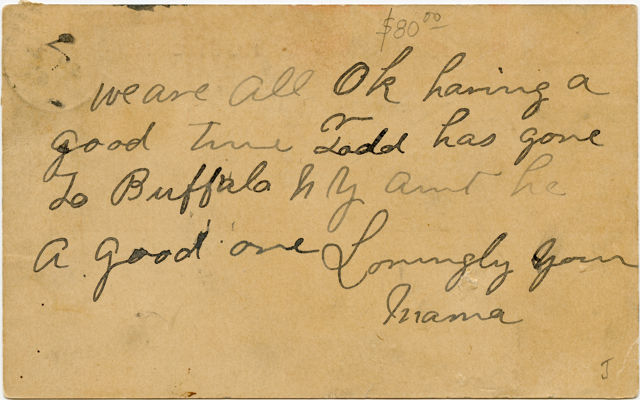
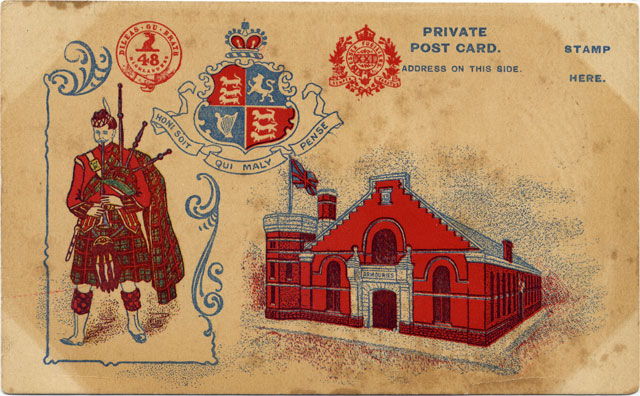
48th Highlanders
Dileas Gu Brath
XXI Essex Fusiliers
Semper Paratus
Private Post Card
Address on This Side
Stamp Here
Honi Soit Qui Mal Y Pense
[translated from Old French as “Shame be to him who thinks evil of it”]
Postally unused
In 1885, the Essex Scottish Regiment was founded, first named 21st Essex Battalion of Infantry. Based in Windsor, Ontario, in 1887 their name was changed to 21st Battalion, Essex Fusiliers, and in 1900, the name was changed again to 21st Regiment, Essex Fusiliers. The 48th Highlanders was formed in 1891 in Toronto, and saw action in the Boer War with the Royal Canadian Regiment in the First Contingent.
This postcard shows Windsor armouries, built between January 1, 1900 and January 1, 1902, designed in the Richardsonian Romanesque style by David Ewart of the Federal Department of Public Works, and a piper, and was likely issued about 1901, possibly in support of soldiers participating in the Boer War. The 25,000 square foot armouries, constructed for $60,000, were used to welcome home the soldiers returning from the Boer War.
Below, a copy postally used from Windsor to Chicago, Illinois, USA on June 10, 1902.
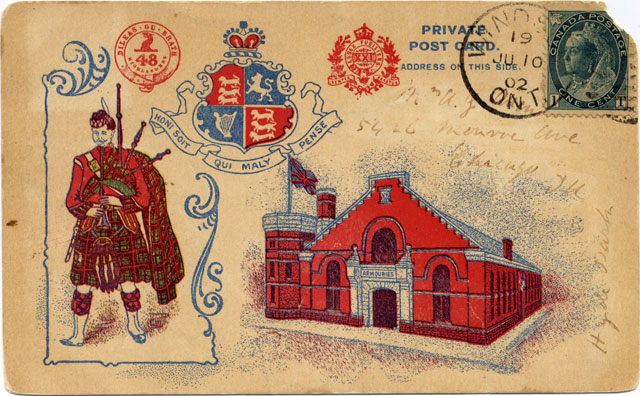
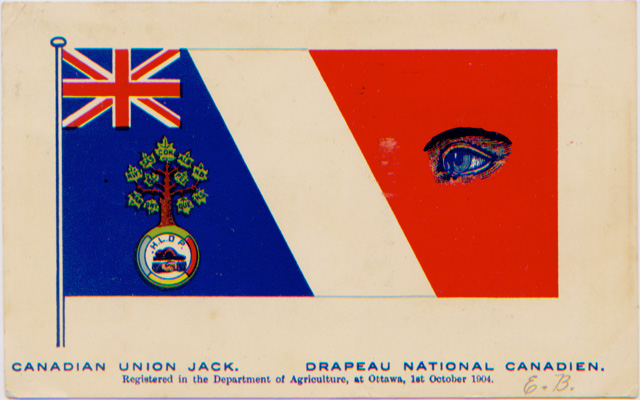
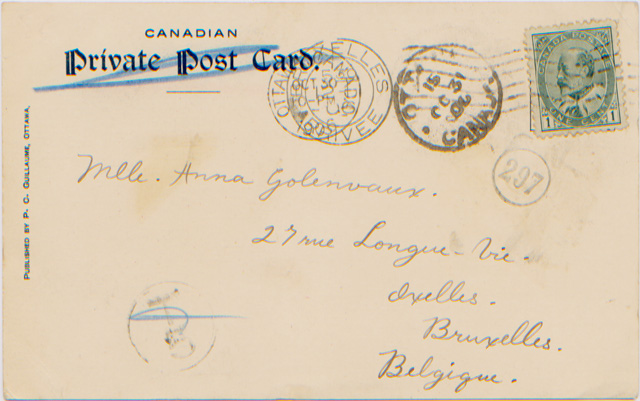
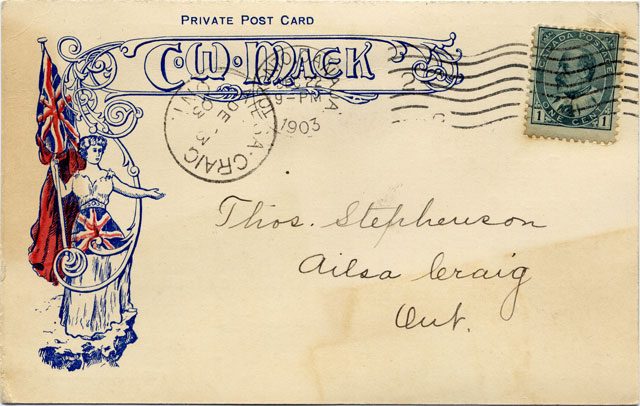
C.W. Mack was inventor of the cushion backed rubber stamp. He was the original owner of what is now Belfountain Conservation Area on the west branch of the Credit River, an hour (by automobile using today’s roads) outside of Toronto. Mack used the property for his summer residence, where he built a waterfall, suspension bridge, and caves, all of which still exist. The company currently is located in Ajax, Ontario.
Below, the reverse of the card showing “C.W. Mack Rubber Stamps and Supplies Wholesale & Retail” acknowledging receipt of payment.
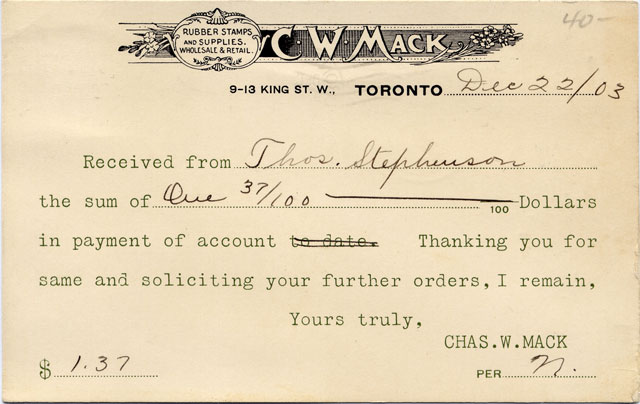
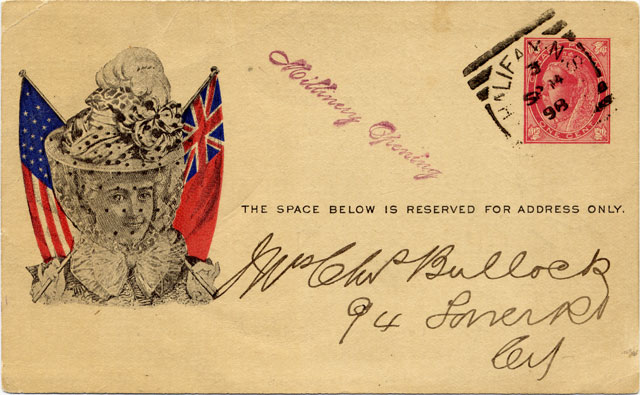
Below, the reverse of the card showing the advertising for Le Bon Marché, F.A. Marr, corner of Barrington and Sackville Streets, Halifax NS.
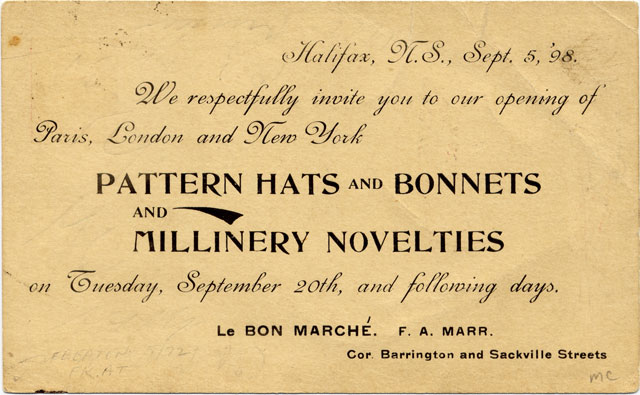
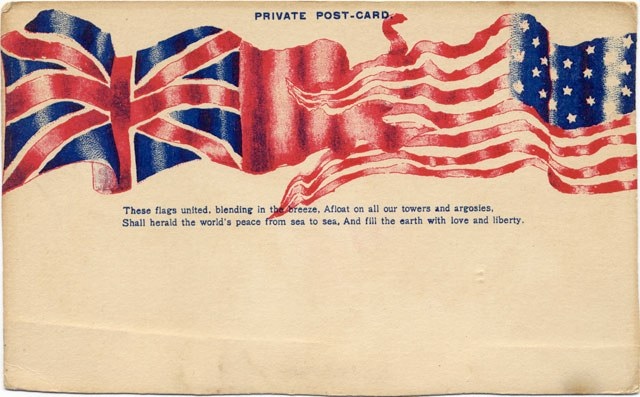
“These flags united, blending in the breeze, Afloat on all our towers and argosies,
Shall herald the world’s piece from sea to sea, And fill the earth with love and liberty.”
This pioneer patriotic postcard, from an unknown publisher, likely dates to about 1898, when there was a strong sentiment for strengthening the Anglo-Saxon ties between Britain and the USA. This sentiment is also expressed in the patriotic postcards of J.C. Wilson’s Anglo-Saxon and Anglo-Saxon League designs of that era. The card bears what appears to be a Red Ensign flag horizontally cut down to look like a Union Jack with a red border intertwined with the Old Glory flag of the USA. The Canadian Red Ensign was used as early as 1868 on an informal basis. Despite its lack of official status, the Red Ensign flew over the Parliament Buildings in Ottawa until 1904 when it was replaced by the Union Jack.
While not accurately depicted, the flag at the right of the card is likely the 45 star flag of the United States of America. This iteration of the flag became the official US flag on July 4th, 1896, lasting for 12 years.
The back of the card is blank.

Below, the reverse of the card.
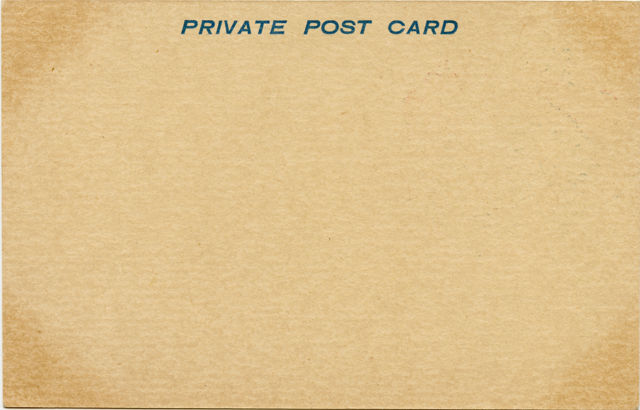
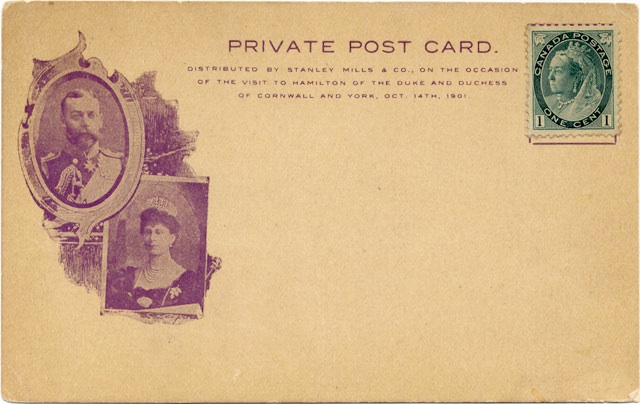
The Duke & Duchess went on to become King George V and Queen Mary. Stanley Mills & Co., a Hamilton-based publisher, also distributed a series of Albertype postcards showing scenes of Hamilton.
While in Canada, the Duke presented newly minted South African War medals to veterans of the Boer War in a Royal Review ceremony in Toronto on October 11, 1901. The Canadian leg of the tour started in Quebec on September 16th, and also included Halifax, before departing from Newfoundland.
The dukedom of Cornwall can only be held by the oldest living son of the monarch who is also heir apparent. On the death of Queen Victoria on January 22, 1901, when King Edward VII ascended the throne, his son, George, inherited the titles of Duke of Cornwall and Duke of Rothesay, and for much of the rest of that year, he was styled His Royal Highness The Duke of Cornwall and York.
The Duke, ascended the throne as King George V, King of the United Kingdom and the British Dominions, and Emperor of India, on May 6, 1910.
